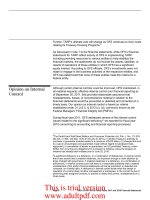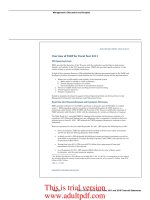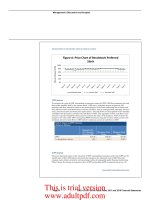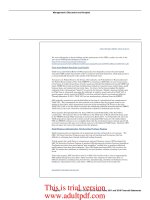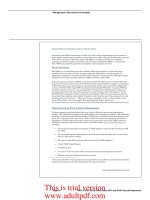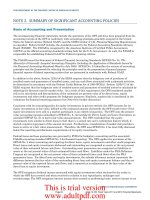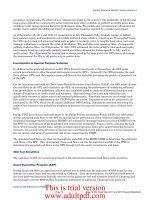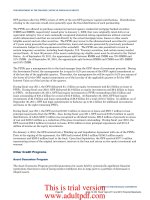United States Government Accountability Office GAO April 2009 Report to the Secretary of the Treasury and the Director of the Office of Management and Budget_part2 doc
Bạn đang xem bản rút gọn của tài liệu. Xem và tải ngay bản đầy đủ của tài liệu tại đây (113.77 KB, 10 trang )
reasonable assurance about whether the financial statements are (1) free
of material misstatements, (2) in conformity with accounting principles
generally accepted in the United States, and (3) presented pursuant to the
requirements of the TFM. Because the Closing Package process requires
verifying agencies to verify and validate the information in the special
purpose financial statements with their audited information and receive an
audit opinion, Treasury is provided a level of assurance that it is compiling
the CFS with audited financial information. All other federal entities that
contribute financial information to the CFS are classified by Treasury as
“nonverifying agencies.” Over 100 nonverifying federal agencies and
entities submitted data for fiscal year 2008. Currently these entities are
only required to submit adjusted trial balance data to Treasury instead of
an audited Closing Package. Because of a lack of criteria for determining
an entity’s significance to the CFS, it is unclear whether any of these
“nonverifying agencies” should be classified as “verifying agencies.”
One of Treasury’s and OMB’s goals for preparing the CFS is to link the
agencies’ audited financial statements to the CFS. To accomplish this goal,
Treasury needs an appropriate level of assurance that it compiles the CFS
using audited Closing Packages from the federal entities contributing the
most significant amounts of financial information. However, without
establishing the criteria for identifying federal entities as significant to the
CFS and establishing related policies and procedures to assess, on an
annual basis, which entities meet such criteria, Treasury and OMB cannot
obtain this level of assurance.
Recommendations for
Executive Action
We recommend that the Secretary of the Treasury direct the Fiscal
Assistant Secretary, in coordination with the Controller of OMB, to
(1) establish and document criteria to be used in identifying federal
entities as significant to the CFS for purposes of obtaining assurance over
the information being submitted by those entities for the CFS and
(2) develop and implement policies and procedures for assessing and
documenting, on an annual basis, which entities met such criteria. These
actions will help provide Treasury and OMB with assurance that the
information being used to prepare the CFS is consistent with the audited
financial statements of the federal agencies, in all material respects.
Page 7 GAO-09-387 Material Weaknesses in Internal Control
This is trial version
www.adultpdf.com
During fiscal year 2008, Treasury enhanced its SOP entitled “Preparing the
Financial Report of the U.S. Government” to require an overall analysis of
the consolidated numbers in the financial statements to include a review
for reasonableness of changes from the prior year to the current year.
However, because of a lack of details on the objectives of the analysis and
the procedures to be performed, the overall analysis did not detect
significant errors in amounts used to prepare the Statements of Net Cost
(SNC).
Procedures for
Reviewing the
Statements of Net
Cost
Internal control should provide, among other things, reasonable assurance
that financial reporting is reliable. GAO’s Standards for Internal Control in
the Federal Government
10
defines the minimum level of quality acceptable
for internal control in the federal government and provides the standards
against which internal control is to be evaluated. These standards state
that internal controls should include, among other items, reviews by
management at the functional or activity level.
Treasury categorizes and allocates costs in the SNC by agency. For
example, most of the costs associated with pension and health benefits
that are reported by the Office of Personnel Management (OPM) in its
financial statements are allocated to the costs of OPM’s federal user
agencies for governmentwide federal reporting purposes. Treasury uses
head count figures reported by OPM in its Closing Package to perform the
allocation of pension and health benefit costs across all user federal
agencies. However, we found that Treasury did not detect a significant
variance in head count between certain federal entities from 2007 to 2008,
which resulted in significant errors in the draft SNC. Specifically, we found
that, in fiscal year 2007, the head count used for the Department of
Defense (DOD) was 497,724, and the head count used for “all other
entities” was 92,566.
11
In fiscal year 2008, we found that the head counts
were erroneously reversed. The head count used for DOD was 95,157,
while the head count used for “all other entities” was 495,673. Treasury’s
review process and overall analysis did not detect this error. As a result,
Treasury’s draft SNC understated DOD’s reported costs on the fiscal year
2008 SNC by approximately $10 billion and costs for the “all other entities”
line item was equally overstated. Without sufficiently detailed procedures
10
GAO/AIMD-00-21.3.1.
11
“All other entities,” a line item on the Statement of Net Cost (SNC), consists of entities not
individually listed on the SNC. The entities in the “all other entities” line item are
individually not deemed significant agencies by Treasury.
Page 8 GAO-09-387 Material Weaknesses in Internal Control
This is trial version
www.adultpdf.com
including guidance for performing the analysis and review of data used in
the allocation process for compiling the SNC, significant errors could
occur in the SNC and not be detected.
Recommendation for
Executive Action
We reaffirm our recommendation that the Secretary of the Treasury direct
the Fiscal Assistant Secretary to further enhance the SOP entitled
“Standard Operating Procedures for Preparing the Financial Report of the
U.S. Government” to better ensure that CFS compilation practices are
proper, complete, and can be consistently applied, including detailed
procedures for conducting reviews and documenting reasonableness of
data used in the process for compiling the CFS.
Agency Comments
and Our Evaluation
OMB Comments
In oral comments on a draft of this report, OMB stated that it generally
concurred with the new findings and related recommendations in this
report. In addition, OMB provided technical comments, which we have
incorporated as appropriate.
Treasury Comments
In its April 15, 2009, written comments on a draft of this report, which are
reprinted in appendix II, Treasury stated that it concurs with the new
recommendations and expects to implement them by the end of fiscal year
2009. We will evaluate the actions taken to address our recommendations
as part of our fiscal year 2009 CFS audit.
This report contains recommendations to the Secretary of the Treasury.
The head of a federal agency is required by 31 U.S.C. § 720 to submit a
written statement on actions taken on these recommendations. You should
submit your statement to the Senate Committee on Homeland Security and
Governmental Affairs and the House Committee on Oversight and
Government Reform within 60 days of the date of this report. A written
statement must also be sent to the House and Senate Committees on
Appropriations with the agency’s first request for appropriations made
more than 60 days after the date of the report.
Page 9 GAO-09-387 Material Weaknesses in Internal Control
This is trial version
www.adultpdf.com
We are sending copies of this report to the Chairman and Ranking Member
of the Senate Committee on Homeland Security and Governmental Affairs
and its Subcommittee on Federal Financial Management, Government
Information, Federal Services, and International Security and the
Chairman and Ranking Member of the House Committee on Oversight and
Government Reform and its Subcommittee on Government Management,
Organization, and Procurement. In addition, we are sending copies to the
Fiscal Assistant Secretary of the Treasury, the Director of OMB, the
Deputy Director for Management of OMB, and the Acting Controller of
OMB’s Office of Federal Financial Management. This report is also
available at no charge on GAO’s Web site at .
We acknowledge and appreciate the cooperation and assistance provided
by Treasury and OMB during our audit. If you or your staff have any
questions or wish to discuss this report, please contact me
(202) 512-3406 or Key contributors to this report are
Gary T. Engel
listed in appendix III.
Director
gement and Assurance
Financial Mana
Page 10 GAO-09-387 Material Weaknesses in Internal Control
This is trial version
www.adultpdf.com
Appendix I: Status of Treasury’s and OMB’s
Progress in Addressing GAO’s Prior Year
Recommendations for Preparing the CFS
Appendix I: Status of Treasury’s and OMB’s
Progress in Addressing GAO’s Prior Year
Recommendations for Preparing the CFS
This appendix includes the status of recommendations from the following
six reports that were open at the beginning of our fiscal year 2008 audit:
Financial Audit: Process for Preparing the Consolidated Financial
Statements of the U.S. Government Needs Improvement, GAO-04-45
(Washington, D.C.: Oct. 30, 2003);
Financial Audit: Process for Preparing the Consolidated Financial
Statements of the U.S. Government Needs Further Improvement,
GAO-04-866 (Washington, D.C.: Sept. 10, 2004);
Financial Audit: Process for Preparing the Consolidated Financial
Statements of the U.S. Government Continues to Need Improvement,
GAO-05-407 (Washington, D.C.: May 4, 2005);
Financial Audit: Significant Internal Control Weaknesses Remain in
Preparing the Consolidated Financial Statements of the U.S.
Government, GAO-06-415 (Washington, D.C.: Apr. 21, 2006);
Financial Audit: Significant Internal Control Weaknesses Remain in the
Preparation of the Consolidated Financial Statements of the U.S.
Government, GAO-07-805 (Washington, D.C.: July 23, 2007); and
Financial Audit: Material Weaknesses in Internal Control over the
Processes Used to Prepare the Consolidated Financial Statements of the
U.S. Government, GAO-08-748 (Washington, D.C.: June 17, 2008).
Recommendations from these reports that were closed in prior years are
not included in this appendix. This appendix includes the status of the
56 remaining open recommendations, according to the Department of the
Treasury (Treasury) and the Office of Management and Budget (OMB), as
well as our own assessments. Explanations are included in the status of
recommendations per GAO when Treasury and OMB disagreed with our
recommendation or our assessment of the status of a recommendation.
We will continue to monitor Treasury’s and OMB’s progress in addressing
GAO’s recommendations.
Of the 56 recommendations relating to the processes used to prepare the
consolidated financial statements of the U.S. government (CFS) that are
listed in this appendix, 16 were closed and 40 remained open as of
December 9, 2008, the date of our report on the audit of the fiscal year
2008 CFS.
Page 11 GAO-09-387 Material Weaknesses in Internal Control
This is trial version
www.adultpdf.com
Appendix I: Status of Treasury’s and OMB’s
Progress in Addressing GAO’s Prior Year
Recommendations for Preparing the CFS
Table 1: Status of Treasury’s and OMB’s Progress in Addressing GAO’s Prior Year Recommendations for Preparing the CFS
(as of December 9, 2008)
Status of recommendation
Count No. Recommendation Per Treasury and OMB Per GAO
GAO-04-45 (results of the fiscal year 2002 audit)
1 02-4
As the Department of the
Treasury (Treasury) is
designing its new financial
statement compilation
process to begin with the
fiscal year 2004 CFS, the
Secretary of the Treasury
should direct the Fiscal
Assistant Secretary, in
coordination with the
Controller of the Office of
Management and Budget
(OMB), to develop
reconciliation procedures that
will aid in understanding and
controlling the net position
balance as well as eliminate
the plugs previously
associated with compiling the
CFS.
To eliminate or explain
adjustments to net position,
Treasury has continued to
eliminate, at the consolidated
level, intragovernmental activity
and balances using formal
balanced accounting entries (via
Reciprocal Categories) and has
continued its analysis of
transactions that contribute to the
unmatched transactions and
balances adjustment. Major
contributors to the plug are
transactions with the General
Fund (Reciprocal Category 29).
In fiscal year 2008, a Treasury
Task Force was formed to
develop an accounting model for
the General Fund. Treasury
continues to separately identify
General Fund transactions to
facilitate their agency
reconciliation. Also in fiscal year
2008, Treasury focused its efforts
on particular areas (fiduciary and
employee benefits) and
increased its analysis and
monitoring efforts on agencies’
explanations of material
differences with their trading
partners.
Open. Treasury has
continued developing
reconciliation procedures to
aid in understanding the
net position balance but
remains unable to eliminate
the plugs associated with
compiling the CFS. In
addition, there are
hundreds of billions of
dollars of unreconciled
differences between the
General Fund and federal
agencies related to
appropriation and other
intragovernmental
transactions. The ability to
reconcile these
transactions is hampered
because not all General
Fund transactions are
reported in the Department
of the Treasury’s financial
statements.
Page 12 GAO-09-387 Material Weaknesses in Internal Control
This is trial version
www.adultpdf.com
Appendix I: Status of Treasury’s and OMB’s
Progress in Addressing GAO’s Prior Year
Recommendations for Preparing the CFS
Status of recommendation
Count No. Recommendation Per Treasury and OMB Per GAO
2 02-6
As OMB continues to make
strides to address issues
related to intragovernmental
transactions, the Director of
OMB should direct the
Controller of OMB to develop
policies and procedures that
document how OMB will
enforce the business rules
provided in OMB
Memorandum M-07-03,
Business Rules for
Intragovernmental
Transactions.
The business rules were revised
in fiscal year 2006 to expand and
enhance the standard practices
for how federal agencies do
business with each other. The
revised rules are published in
Treasury Financial Manual (TFM)
Bulletin 2007-03.
OMB, Treasury, and the Chief
Financial Officers’ Council
(CFOC) are distributing quarterly,
a “Watchlist” of the largest dollar
imbalances between two federal
agencies and/or federal agencies
not reporting a trading partner.
Federal agencies on the
“Watchlist” meet with OMB and
Treasury to discuss the root
causes of the imbalances and
come to resolution on how to
mitigate the root causes. At the
same time, OMB, Treasury, and
the CFOC are continuing their
efforts toward establishing the
Intragovernmental Dispute
Resolution Committee (IDRC), as
referenced in the business rules.
The IDRC will be a vehicle for
resolving accounting disputes
between federal agencies. The
dispute resolution process is also
predicated on the principle that
federal agencies have
implemented the business rules
and will require the disputing
federal agencies to provide
evidence of compliance with the
business rules during arbitration.
Open.
Page 13 GAO-09-387 Material Weaknesses in Internal Control
This is trial version
www.adultpdf.com
Appendix I: Status of Treasury’s and OMB’s
Progress in Addressing GAO’s Prior Year
Recommendations for Preparing the CFS
Status of recommendation
Count No. Recommendation Per Treasury and OMB Per GAO
3 02-7 As OMB continues to make
strides to address issues
related to intragovernmental
transactions, the Director of
OMB should direct the
Controller of OMB to require
that significant differences
noted between business
partners be resolved and the
resolution be documented.
OMB will continue to work with
individual federal agencies to
resolve imbalances that are
referred to OMB on a case-by-
case basis. As part of OMB’s
standard practice, resolutions
reached will be communicated to
all parties. As noted above,
OMB, Treasury, and the CFOC
are documenting the imbalances
identified on the “Watchlist” and
subsequent resolutions. OMB,
Treasury, and the CFOC will
continue to work toward
establishing the IDRC, as
referenced in the business rules,
and it will be used as a vehicle
for federal agencies to resolve
their accounting disputes. The
IDRC will incorporate a standard
practice of documenting all
resolutions and communicating
the resolutions to all parties
involved.
Open.
Page 14 GAO-09-387 Material Weaknesses in Internal Control
This is trial version
www.adultpdf.com
Appendix I: Status of Treasury’s and OMB’s
Progress in Addressing GAO’s Prior Year
Recommendations for Preparing the CFS
Status of recommendation
Count No. Recommendation Per Treasury and OMB Per GAO
4 02-9
The Secretary of the Treasury
should direct the Fiscal
Assistant Secretary, in
coordination with the
Controller of OMB, to design
procedures that will account
for the difference in
intragovernmental assets and
liabilities throughout the
compilation process by
means of formal consolidating
and elimination accounting
entries.
Treasury has designed formal
consolidating and eliminating
procedures to account for these
differences and has implemented
them. See the status for
recommendation No. 02-4.
Open. Treasury’s formal
consolidating and
eliminating accounting
entries could not fully
account for the difference
in intragovernmental assets
and liabilities during the
fiscal year 2008
compilation process. For
example, there are
hundreds of billions of
dollars of unreconciled
differences between the
General Fund and federal
agencies related to
appropriation and other
intragovernmental
transactions. These
amounts are not eliminated
by Treasury’s formal
consolidating and
elimination accounting
entries due to the fact that
Treasury’s ability to
reconcile these
transactions is hampered
because not all General
Fund transactions are
reported in the Department
of the Treasury’s financial
statements. As indicated in
Treasury’s response to
recommendation No. 02-4,
additional analysis of the
General Fund is necessary
to account for all
differences in
intragovernmental assets
and liabilities.
Page 15 GAO-09-387 Material Weaknesses in Internal Control
This is trial version
www.adultpdf.com
Appendix I: Status of Treasury’s and OMB’s
Progress in Addressing GAO’s Prior Year
Recommendations for Preparing the CFS
Status of recommendation
Count No. Recommendation Per Treasury and OMB Per GAO
5 02-10
The Secretary of the Treasury
should direct the Fiscal
Assistant Secretary, in
coordination with the
Controller of OMB, to develop
solutions for
intragovernmental activity and
balance issues relating to
federal agencies’ accounting,
reconciling, and reporting in
areas other than those OMB
now requires be reconciled,
primarily areas relating to
appropriations.
Treasury continues to provide to
federal agencies information from
its Central Accounting and
Reporting System (STAR)
related to appropriations,
transfers, and fund balance with
Treasury for the agencies’ use in
reconciling with this centrally
reported data. The agencies will
be required to reconcile with this
information in fiscal year 2009.
Open. Treasury and OMB
did not provide federal
agencies instructions on
how to reconcile and report
to Treasury any differences
between their records and
Treasury’s central
accounting records.
Further, although
Treasury’s analysis of
agencies’ transactions with
the General Fund is
ongoing, the ability to
reconcile these
transactions is hampered
because not all General
Fund transactions are
reported in the Department
of the Treasury’s financial
statements.
6 02-11 The Secretary of the Treasury
should direct the Fiscal
Assistant Secretary, in
coordination with the
Controller of OMB, to
reconcile the change in
intragovernmental assets and
liabilities for the fiscal year,
including the amount and
nature of all changes in
intragovernmental assets or
liabilities not attributable to
cost and revenue activity
recognized during the fiscal
year. Examples of these
differences would include
capitalized purchases, such
as inventory or equipment,
and deferred revenue.
The current reconciliation of
intragovernmental activity does
account for differences caused
by asset capitalization and
agency advances or deferred
revenue. Given current
intragovernmental differences,
further resolution of this activity is
contingent on these differences
being materially resolved. See
status of recommendation
No. 02-4.
Open.
Page 16 GAO-09-387 Material Weaknesses in Internal Control
This is trial version
www.adultpdf.com

